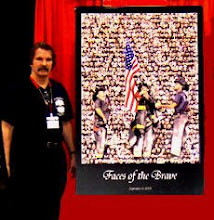WTC Memorial Mission Statement
The memorial mission statement serves as a compass to guide not only the creation of the memorial, but also its evolution through the ages.Memorial Mission Statement For the World Trade Center Site:Remember and honor the thousands of innocent men, women and children murdered by terrorists in the horrific attacks of February 26, 1993 and September 11, 2001.
Respect this place made sacred through tragic loss.
Recognize the endurance of those who survived, the courage of those who risked their lives to save others, and the compassion of all who supported us in our darkest hours.
May the lives remembered, the deeds recognized and the spirit reawakend be eternal beacons, which reaffirm respect for life, strengthen our resolve to preserve freedom, and inspire an end to hatred, ignorance and intolerance.Memorial Program Guiding Principles and Elements:The memorial program is comprised of Guiding Principles and Elements. The Guiding Principles are the aspirations that must be embodied within and conveyed through the memorial. Program Elements provide memorial designers with a list of specific elements that should be physically included in the memorial, without prescribing how or inhibiting creativity.Notes from the Draft Memorial Program CommitteeThe memorial program drafting committee began and ended its task by invoking the letter and spirit of the mission statement. The committee discussed how to translate the goals of the mission statement into concepts and program elements for a design competition. It was essential to the committee that the program provide clear guidance, while also allowing for the most creative response possible by designers.This balance was achieved in the program document through the careful consideration, and phrasing, of each program concept and element. Particular attention was devoted to discussing individual representation of victims, the interpretation and meaning of sacred space, the power of the footprints and the authentic character of elements and artifacts that survived. The program drafting committee wants the memorial and site planning processes to influence and be coordinated with one another for mutual benefit. The memorial program will be used as one of the criteria for the site plan selection. Once the memorial designer is selected, both the memorial designer and site planner will work together to integrate their efforts.Memorial Program for the World Trade Center Site Program Guiding Principles:The memorial is to:-Embody the goals and spirit of the mission statement-Convey the magnitude of personal and physical loss at this location-Acknowledge all those who aided in rescue, recovery and healing-Respect and enhance the sacred quality of the overall site and the space designated for the memorial.-Encourage reflection and contemplation; evoke the historical significance and worldwide impact of September 11, 2001-Create an original and pwerful statement of enduring and universal symbolism-Inspire and engage people to learn more abou tthe events and impact of September 11, 2001 and February 26, 1993; and evolve over time Program Elements:The memorial should: Recongize each individual who was a victim of the attacks-Victims of the September 11, 2001 attacks in New York, Virginia and Pennsylvania-Victims of the 1993 terrorist bombing of the World Trade CenterProvide a space for comtemplation-an area for quiet visitation and contemplation-an area for families and loved ones of victims-separate accessible space to serve as a final resting-place for the unidentified remains from the World Trade Center siteCreate a unique and powerful setting that will-Be distinct from other memorial structures like a museum or visitor center-Make visible the footprints of the original World Trade Center towers-Include appropriate transitions or approaches to, or within, the memorialConvey Historic AuthenticityThe memorial or its surrounding areas may include:-Surviving original elements-Preservation of existing conditions of the World Trade Center site-Allowances for public ceremonies and celebrations
WTC Redevelopment Timeline
The amorphous plans for the redevelopment of the World Trade Center site were given a reference point on the Fourth of July 2004, when the cornerstone of the Freedom Tower was ceremoniously laid. The event was meant to kick off the clamor of construction and deconstruction to take place in the months and years ahead. Most of the building in the immediate future will be focused on the substructures of the towers, to be completed by 2009, and the revitalization of the transportation systems converging in Lower Manhattan. Construction on the Reflecting Absence memorial begins in 2005, and should be significantly finished by 2009. The Freedom Tower, also known as “Tower One” or the “1776 Tower,” is set to be completed in 2007, with all the steel built and retail centers on the bottom floors open by 2006. When contacted, the Lower Manhattan Development Corporation could not confirm completion dates for the other towers, since funding and designs continue to be ephemeral components of the process. However, the LMDC is concerned with dedicating maximum assistance to redeveloping the site. Deconstruction of the Deutsche Bank building will begin later this year, and will be the future home of Tower 5. Calatrava’s beautiful permanent WTC PATH terminal will open in 2006. The new Fulton Street Transit Center by Grimshaw, linking MTA Subway, PATH, and pedestrian tunnels downtown, will open in 2007. Construction of Fulton and Greenwich Streets through the WTC center site is slated for completion by 2009, though the LMDC would not commit to those plans. The rebuilding of West Street along the eastern slurry wall of the World Trade Center site is equally uncertain. Lower Manhattan will soon be a bustling transportation hub, but a web of new construction until at least 2015. Please check back here for updates on the redevelopment timeline.
2004
July 4th Freedom Tower cornerstone laid
Deutsche Bank Building deconstruction begins
2005
Slurry Wall permanent reinforcement complete
Deutsche Bank deconstruction complete
Reflecting Absence Memorial construction begins
2006
WTC PATH terminal opens
Freedom Tower steel and retail complete
2007
Fulton Street Transit Center opens
Freedom Tower complete
2008
Construction of Fulton and Greenwich Streets through WTC complete (possibly 2009)
2009
WTC PATH and Fulton Street Transit Center fully complete and linked by pedestrian connections.
Reflecting Absence Memorial Mostly Complete
Based on information provided by the LMDC website as of 7/19/04

